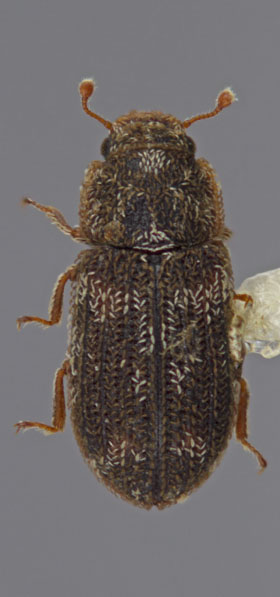 |
 Previous Genus Next Genus Previous Genus Next Genus 
Genus: Microsicus
Diagnostic Features
- Description: Antennae 10-segmented with a distinct, 1-segmented club. Antennal setation sparse. Subantennal grooves absent. Eyes large, well-developed, finely faceted. Pronotal disc convex, simple. Procoxal cavities open. Metacoxae narrowly separated, separation less than metacoxal length. Tarsal formula 4-4-4. Dorsal surface with strongly curved, flattened, multi-colored setae.
- Similar genera: The genus Microsicus is similar in general appearance to the other genera with 10-segmented antennae and a 1-segmented club that lack a subantennal groove, including Synchita, Paha, and Endeitoma. Synchita differs in having short, bristle-like, unicolored setae. The genus Paha differs in lacking obvious dorsal pubescence, lateral pronotal margins widest anteriorly and distinctly explanate, and having paired carinae on the pronotal disc. Endeitoma differs in having a long third antennal segment (at least twice as long as segment 4), lateral pronotal margins distinctly denticulate, and a dorsal pubescence consisting of thin, fine, hair-like setae. In Microsicus, the pronotal disc is simple, the lateral margins are not distinctly denticulate, antennal segment 3 is not distinctly elongate, and the dorsal pubescence consists of strongly curved, flattened, multi-colored setae.
Known Distribution
- Northeast (DE, MD, PA, WV, VA), North Central (IN), Southeast (FL, GA, NC), South Central (AR, OK), Northwest (OR, ID), Southwest (CA, AZ) USA.
Biology
- Microsicus has been collected at MV/UV lights, but can commonly be found under the bark of various dead trees, including cottonwood (M. variegatus), oak (M. parvulus, M. obscurus), and hickory (M. parvulus, M. obscurus).
- Abundance: Moderately common.
North American Species (3)
Species Diagnoses
- Microsicus variegatus: Elytra variegated, with weak carinae, west of 100th meridian. Distribution: Idaho, Oregon, California, and Arizona, USA.
- Microsicus parvulus: Elytra without carinae, eyes large, elongate, head without temples, east of 100th meridian. Distribution: Delaware, Indiana, Maryland, Pennsylvania, Arkansas, Florida, Georgia, North Carolina, West Virginia, Virginia, and Oklahoma, USA.
- Microsicus obscurus: Elytra without carinae, eyes smaller, round, protruding, head with temples, east of 100th meridian. Distribution: Washington D.C., Pennsylvania, New Jersey, and Oklahoma, USA. The true distribution of this species is probably much larger than records indicate.
Discussion
- This genus is most closely allied to Synchita, with little difference other than setation type and pattern to distinguish between the two.
Selected References
|
 |
 
Microsicus obscurus
© N.P. Lord |


